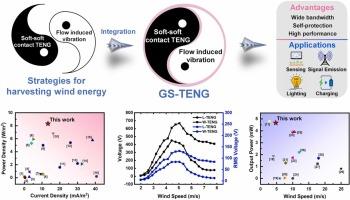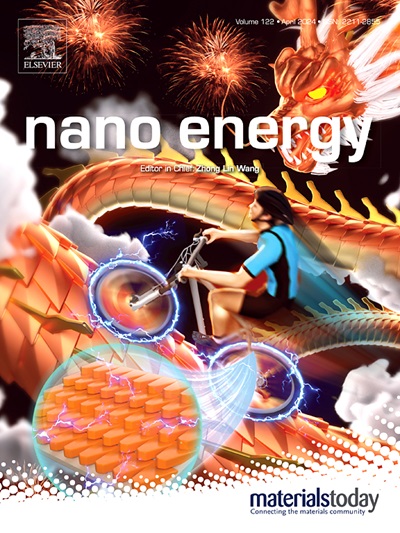利用非线性耦合奔腾现象采集风能的软-软接触 TENG
IF 16.8
1区 材料科学
Q1 CHEMISTRY, PHYSICAL
引用次数: 0
摘要
三电纳米发电机(TENG)可以有效地将风能转化为电能,为风能收集提供了有效的解决方案。本文提出了一种基于非线性耦合奔腾现象的新型软-软接触 TENG(GS-TENG)。利用柔软的 Ecoflex 泡沫薄膜和柔软的弹簧钢片实现了软-软接触。通过发泡技术在 Ecoflex 薄膜上构建了微球结构表面,从而有效提高了三电材料的表面电荷密度。因此,三电材料的开路电压最高可达 1700 V。此外,GS-TENG 还能在高风速下通过主动降低风速振幅实现自我保护,并具有超宽工作带宽(2.292 m/s∼>7.8 m/s)。当风速达到 4.74 m/s 时,GS-TENG 可产生高达 4.67 mW 的输出功率。值得注意的是,GS-TENG 的流动诱导振动双质量系统结构可能为流动诱导振动 TENG 的新设计模式铺平道路。GS-TENG 可以连续驱动电子时钟,并通过风能收集成功驱动无线温度传感系统。这些结果表明,我们开发的 GS-TENG 在风能收集方面具有很高的效率,这项工作极大地促进了 TENG 的实际应用。本文章由计算机程序翻译,如有差异,请以英文原文为准。

Soft-soft contact TENG using nonlinear coupling galloping phenomenon for harvesting wind energy
Wind energy can be efficiently converted into electricity by the triboelectric nanogenerator (TENG), which provides an effective solution for wind energy harvesting. Here, a novel soft-soft contact TENG based on nonlinear coupling galloping phenomenon (GS-TENG) was proposed. Soft-soft contact was achieved utilizing soft Ecoflex foam film and soft spring steel sheet. A microsphere structured surface was constructed on the Ecoflex film through foaming technology, which increases the surface charge density of the triboelectric materials effectively. Accordingly, the open-circuit voltage of triboelectric materials can reach up to 1700 V. Moreover, the GS-TENG is capable of self-protection under high wind speeds by actively reducing its amplitude and features an ultra-wide working bandwidth (2.292 m/s∼>7.8 m/s). When the wind speed reaches 4.74 m/s, the GS-TENG can generate up to 4.67 mW of output power. Notably, the GS-TENG’s flow-induced vibration dual mass system structure may pave the way for a new design paradigm in flow-induced vibration TENGs. GS-TENG can drive electronic clocks continuously and drive wireless temperature sensing systems successfully by wind energy harvesting. These results demonstrate that the GS-TENG we developed has high efficiency in wind energy harvesting, and this work greatly promotes the practical application of TENGs.
求助全文
通过发布文献求助,成功后即可免费获取论文全文。
去求助
来源期刊

Nano Energy
CHEMISTRY, PHYSICAL-NANOSCIENCE & NANOTECHNOLOGY
CiteScore
30.30
自引率
7.40%
发文量
1207
审稿时长
23 days
期刊介绍:
Nano Energy is a multidisciplinary, rapid-publication forum of original peer-reviewed contributions on the science and engineering of nanomaterials and nanodevices used in all forms of energy harvesting, conversion, storage, utilization and policy. Through its mixture of articles, reviews, communications, research news, and information on key developments, Nano Energy provides a comprehensive coverage of this exciting and dynamic field which joins nanoscience and nanotechnology with energy science. The journal is relevant to all those who are interested in nanomaterials solutions to the energy problem.
Nano Energy publishes original experimental and theoretical research on all aspects of energy-related research which utilizes nanomaterials and nanotechnology. Manuscripts of four types are considered: review articles which inform readers of the latest research and advances in energy science; rapid communications which feature exciting research breakthroughs in the field; full-length articles which report comprehensive research developments; and news and opinions which comment on topical issues or express views on the developments in related fields.
 求助内容:
求助内容: 应助结果提醒方式:
应助结果提醒方式:


